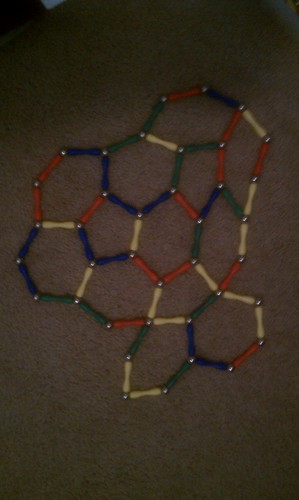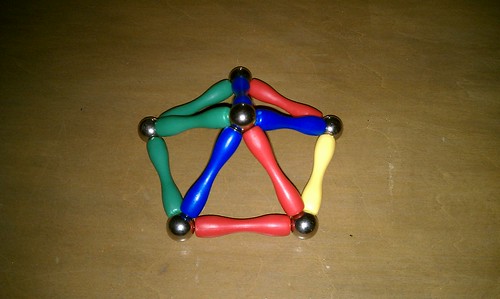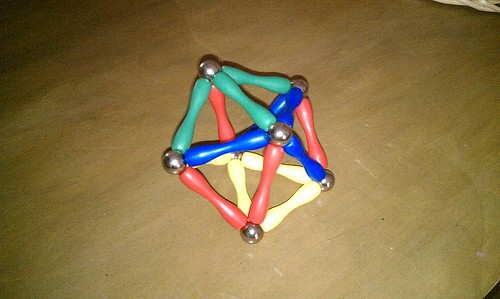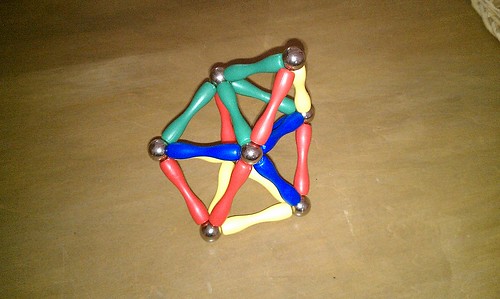So Kimberly left for a few days to go to meetings, which gave me the run of the house. Thanks to my personal book recommendation engine (aka Julie), I read Michael Crichton's Prey... given my interest in the subject matter, I ended up finishing it in about ten hours over two days.
By that time I was thoroughly informed about the promise and pitfalls of nanotechnology, but sans Internet (I hate you, AT&T!), I was soon looking for something to fiddle with. Then I found Kimberly's stash of toys - namely, her magnetic building set. You know the type - the set with the sticks with magnets at each end and ball bearings for joints. So I start to fiddle around. I begin with basic solids like pyramids and cubes, but of course my mind starts to wander, and I begin to wonder if I could pull off a Buckminsterfullerine molecule.
Buckminsterfullerine molecules, or Buckyballs for short, are a special type of fullerite, a specialized carbon molecule. Buckyballs have the shape of a geodesic dome (or a typical soccer ball, for those uninitiated in architecture), and are mathmatically referred to as a 'truncated icosahedron.' Here's a model:
The principle is fairly basic: a pentagon sprouting five hexagons from its sides, then jamming pentagon points in the resultant notches around the perimeter and surrounding those with hexagons, and so on. So I began to build. I thought I had a home run, and was on my way to a masterpiece that I could bronze and display in the living room. Unfortunately, I ran into some problems. This is as far as ol' Bucky got:

The issue was ultimately weight versus stability. There were a lot of connections, but they were on the outer periphery of the shape I was intending to build. For all their stability in real life, Buckyballs are ultimately hollow all the same - and trying to build one out of Magnetix was a foiled effort. Even if I had three or four people helping me support the sides to make the connections, I think the structure would have collapsed under its own weight.
Undeterred, I knew I could engineer something better. I decided to base my new attempt on a pentagon, but decided against marrying a more complex shape to it. Once I build my base pentagon, I figured that I needed more internal stability for whatever I built. So I decided to give the pentagon a centerpoint and connect it to the vertices:

Then I mirrored the shape:

I scratched my head for a bit here, but ultimately went for marrying a simpler shape to this, and built pyramidal points from the faces of each side:

Continuing to do this on each side, I finally ended up with my finished product:

Say hello to my newly constructed triacontagon - a thirty-sided solid (three exposed pyramidal sides per pentagon face times ten such faces). The shape is pleasantly stable - I can actually move it from one place to another without it shattering, if I'm ginger with it. As I looked at it and thought back to my failed attempt at the Buckyball, I realized that this new shape actually had two fewer sides than Bucky, which is a 32-gon (or a tracontakaidigon, if you want to sound impossibly awesome about it).
And so I started thinking about some of the implications of this. Bucky, for all his stability and good press, is a bit of a maintenance pig. He frays at the edges, begins to get distorted the further you get from the origination point, and never quite comes together. This triacontagon, however, was exponentially more stable. The most connections between any two joints in the shape was three - it was tightly constructed around a defined and stable core.
I think this reflects upon our experience sometimes. We tend to engineer our lives around a generally understood 'ideal' that, ironically, nobody really understands. We're told that our lives will harbor meaning and vitality if we construct them like thus and so, emphasizing this and ignoring that. And so we set about our work, tongue poking out of the side of our mouth, slapping the sticks and joints together. So often, though, we find that the whole thing just won't come together or, at best, we need a bunch of other people to prop it up so it's even functional.
I've found that I'm usually better off when I define my own shape. I'd never seen this particular triacontagon before, but then again, the world's never seen a justifreemagon, either. The point is not making your life look like someone else's ideal, but inner connectedness and stability based on centering your life upon something stable. So what does that mean for you? Beats me. You may have more or fewer sides than me, a larger or smaller overall shape, a varying number of connectors and joints.
The one thing we do have in common is the need for an objective sense of truth. Though our shapes vary, you still have to follow some geometric principles - the need for symmetry, for there to be a limited number of connections stemming from one vertex, and so on. Similarly, our lives only function optimally when we follow a course plotted by the One who knows us better than we know ourselves.
Triacontagons, truncated isohedrons, buckminsterfullerenes...your magnet set is too complicated, Kimmy. I need to get a wooden Tinkertoy set for the house.


3 comments:
DUDE... I love it.
I broke this thing.
top [url=http://www.c-online-casino.co.uk/]uk online casinos[/url] brake the latest [url=http://www.casinolasvegass.com/]casino games[/url] free no store bonus at the leading [url=http://www.baywatchcasino.com/]no lay tip
[/url].
Post a Comment